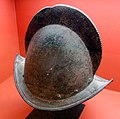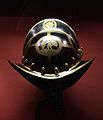Morion (přilba)

Morion byl typ otevřené přilby používané během šestnáctého a na počátku sedmnáctého století. Předpokládá se, že byla poprvé zkonstruována ve Španělsku. Název „morion“ mohl původně souviset s Maury, či španělským slovem morro, znamenající vrchol hlavy.[1]
Historie
Za místo původu typu přilby, označované jako morion, je považováno Kastilské království. Přilba byla součástí vojenské výbavy španělských conquistadorů během jejich výprav na území Severní, Střední a jižní Ameriky. Španělští conquistadoři, především pěší vojáci, používali morion v kombinaci s lehčím brněním, chránícím trup. Díky své relativně nízké pořizovací ceně se stala velmi populární a později se rozšířila do armád po celé Evropě. Dodnes je používána Švýcarskou gardou ve Vatikánu.
Různé typy morionu
Morion ze 17. století, používaný španělskými conquistadory v Jižní Americe
Německý morion z Norimberka, 16. století (Rüstkammer Dresden)
Morion zdobený rytinami (Museum aan de Stroom, Antverpy, Belgie)
Milánská slavnostní přilba (kolem r. 1550)
Morion-cabasset (Metropolitan Museum of Art)
Capacete Ferdinanda II. Aragonského, 1490 (Kunsthistorisches Museum Wien)
Měděná helma podle vzoru evropského morionu (Poso, Sulawesi)
Odkazy
Reference
V tomto článku byl použit překlad textu z článku Morion (helmet) na anglické Wikipedii.
- ↑ Morrion helmet / Casco Morrión [online]. [cit. 2020-10-12]. Dostupné v archivu pořízeném dne 2020-10-12. (španělsky)
Externí odkazy
 Obrázky, zvuky či videa k tématu morion na Wikimedia Commons
Obrázky, zvuky či videa k tématu morion na Wikimedia Commons
Média použitá na této stránce
Autor: Dnalor 01, Licence: CC BY-SA 3.0 at
Rom, Vatikan, Soldat der Schweizer Garde
Autor: unknown, Licence: CC0
en:Morion (helmet) of the king Charles IX. 1555-1560. Pierre Reddon. Purchase 1793. Louvre museum (Paris, France).
Autor:
Autor: Jonathan Cardy, Licence: CC BY-SA 3.0
Morion - 1550s Milanese parade helmet
A copper helmet from Poso, Sulawesi, modelled after European helmet. Transcription from the book:
Copper helmets from Celebes. Caused
through our communication in the previous volume of this Magazine, p. 216, writes Mr Alb to us. C. Kruyt, from Posso, Celebes on March 19 of this year. J .: These helmets also come in Central Celebes in front. I found one with the Topebatu, a second with the Tonapu and a third south of the lake. The natives claim that several more scattered here and there, are present. Of the I am sending a copy found at the Tonapu here is a drawing for you; all are pretty thin brass sheet (approx. 2 mm Thick) done. The round, convex ones visible at the edge raises, the heads of the rivets are through what two layers of sheet metal, forming the edge, with to be connected to each other; are in front two cylinder-shaped bodies, probably for feather bottles for sure. The helmets don't give high concept of the visual appearance of their finished and don't make the impression yet completely accomplished job. The Toradja's living here lierum claim to have received the helmets from the Tomori; with this tribe you can find, as well as through those received there by Messrs. Sakasin imitation from Rotan is proven in the that helmets of this kind. But also through the same Tomori should be made like the Toradja this claim is not acceptable because the helmets show embossed decorations and the tomori not understanding this art, any more than that riveting individual parts, for which the helmets too provide examples. The brass headgear we have met in Parigi, stunned by Ternate. “You see the question of the origin of the helmets is still shrouded in darkness."
In connection with the latter remark, we permit us the information that Drs. A. B. Meyee & Osw. Judges, due to their sub-searches that have come to the conclusion that the Helmets of old Dutch origin, in the 17th century have come to India, and in part for Suitana guards from the Netherlands true (Abh. & Ber. des Kgl. Zool. and Anthr.-Ethn. Museum zu Dresden, 1900/01, Vol. IX N ». 6, pg. 79).A metallic helmet, used approximately in the 17th century by Spanish conquerors in America.
- It's in the Museo del Carmen, Maipú, Santiago de Chile.
Autor: Catalayud manufactury, Aragon., Licence: CC BY 3.0
Capacete (infantry helmet) of Ferdinand II of Aragon, c. 1490
Autor: Pudelek (Marcin Szala), Licence: CC BY-SA 3.0
Rüstkammer, Dresden - morion. Nürnberg,end of the XVI century
















